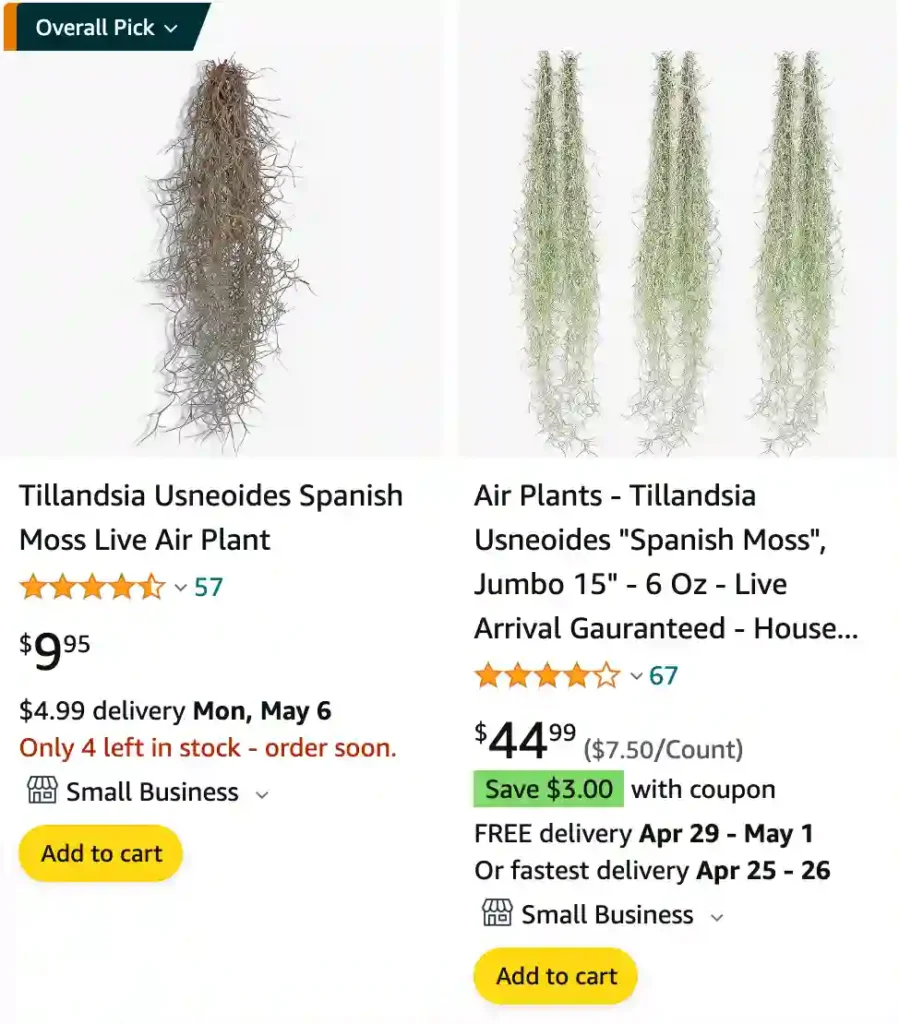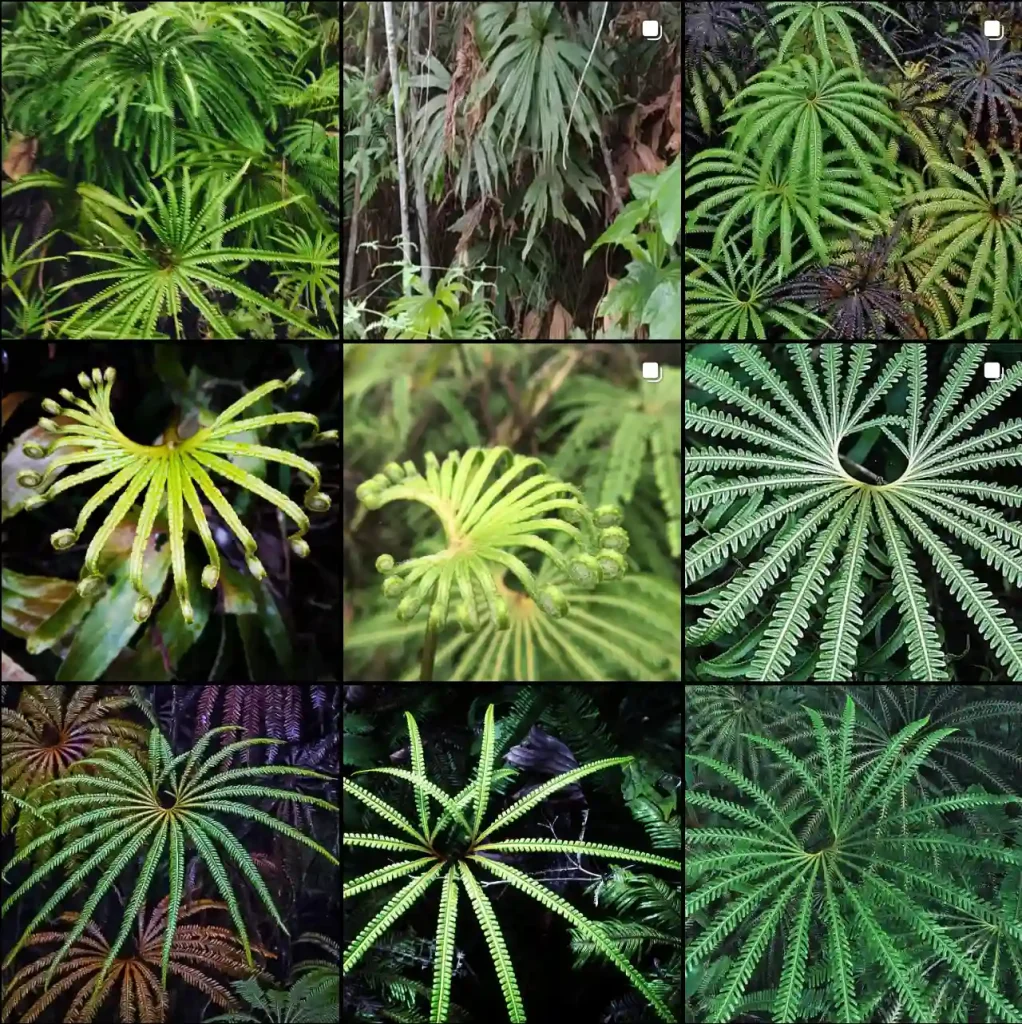
What is Spanish moss?
Spanish moss is something I’ve always loved seeing in the American South. That silvery green draping over majestic live oaks has such a mysterious beauty to it. When I first encountered it during a trip to Savannah, I was mesmerized, wondering if it was a plant or some strange natural fiber. I remember walking under the canopy of those trees draped in moss and trying to touch it – its delicate, wiry, yet surprisingly soft texture was fascinating. Of course, the air felt just a little more humid, with a distinct earthy scent, adding to the whole Southern Gothic atmosphere of the place.
690 Species in Genus Tillandsia – Air Plants
Does Spanish moss kill trees?
Contrary to what some might say, I don’t believe Spanish moss is a tree killer. I’ve seen plenty of vibrant, healthy trees absolutely draped in that moss, especially down in Florida. Sure, sometimes a really heavily laden branch might look weighed down, but I’ve never seen anything truly broken by it. If a branch snaps, it more likely had some underlying weakness already. Those Spanish moss-covered trees seem happy and healthy to me, providing a shady haven for all sorts of interesting creatures – a whole little ecosystem in itself!
How does Spanish moss grow?
I wish I could say I’ve witnessed Spanish moss growing firsthand, but honestly it’s a bit of a mystery to me! I know it has something to do with seeds and those wispy bits getting carried around by the wind or birds. During a swamp tour in Louisiana, I remember our guide mentioning how little pieces of the plant seem to just latch on to trees wherever they land. It seems more like magic than anything I’ve seen in my garden. I suppose those humid conditions must be really perfect for it to thrive.
Is Spanish moss harmful to humans?
I wouldn’t say Spanish moss is harmful, but I’d definitely advise a little caution around it. From what I’ve heard, it can be home to these tiny critters called chiggers, and those bites are no joke! During a picnic in Charleston, some friends and I got way too curious about a big clump that had fallen to the ground. Sure enough, we paid the price—days of itchy red bumps! Lesson learned: admire Spanish moss from a distance. It’s much prettier up on the trees anyway!
Is Spanish moss invasive?
Honestly, I’m not sure if Spanish moss can be considered invasive. It sure can be prolific in some areas – I’ll never forget driving along the coast in Georgia and seeing entire forests draped in the stuff! However, from what I understand, it doesn’t really harm the trees it grows on, just uses them for support. I suppose it might become a bit of a nuisance if it gets too dense, but I think the beauty and unique character it adds to the landscape outweighs any potential downsides.
Where does Spanish moss come from?
While its name makes it sound exotic, Spanish moss is actually a native plant here in the southern US. I always thought it must have originated somewhere tropical, like Central or South America, since that’s where it seems to thrive the most. Imagine my surprise when I learned it extends all the way up to Virginia! I guess there’s still that little bit of mystery for me – I’d love to know how it got its misleading name and traveled so far across different climates.
How to grow Spanish moss?
I’ve never grown Spanish moss myself, but I imagine it takes a pretty specific touch to mimic its natural environment. I know people who’ve had success hanging it on tree branches outdoors in humid spots, especially after a good rain when it can soak up lots of moisture. I also saw someone online who misted theirs regularly indoors with a spray bottle and kept it near a window for bright light. Honestly, it seems like the most important thing is air circulation – if it gets too damp, it might get a little funky. I’m a bit envious of folks with the right conditions for growing this beautiful plant; maybe one day I’ll try it out myself!
Is Spanish moss a parasite?
Nope, Spanish moss definitely isn’t a parasite. I used to think the same thing, especially seeing it so thickly draped over trees. It’s actually a really cool plant called an epiphyte – that means it gets its nutrients and water from the atmosphere, not the tree. It just hitches a ride! I find it fascinating that it can survive like that. I like to think of Spanish moss less as a freeloader and more like a beautiful, self-sufficient tenant living in the high branches.
Why is it called Spanish moss?
I always find the origin of the name “Spanish moss” a bit funny. Apparently, it’s got nothing to do with Spain and isn’t even a true moss! It seems French explorers thought it looked like the long, scraggly beards of Spanish conquistadors. The Spanish got their own back by calling it “French hair”…petty, but historically accurate! I guess the name stuck, though I much prefer the Native American term, “tree hair”. It’s simple and evokes the way it delicately drapes from the branches.
Does Spanish moss have bugs?
Absolutely, Spanish moss has bugs! It’s practically a little ecosystem up there in the branches. I learned my lesson the hard way during a trip to Charleston. My friends and I were fascinated by a fallen clump of moss – until we got covered in itchy red chigger bites! There might be other critters in there too, like spiders and harmless little insects. From then on, I decided Spanish moss is much more interesting and beautiful from a distance, preferably hanging safely out of reach on a majestic tree!
Is it illegal to pick Spanish moss in Florida? Is Spanish moss native to Florida?
From what I understand, it’s not illegal to pick Spanish moss in Florida. In fact, it’s incredibly abundant there and definitely a native plant. While there are other types of protected air plants in the state, Spanish moss is everywhere. I’d still say be mindful about where you take it from. If you have some hanging out on your own property, go ahead! But it might be best to leave it be in parks or natural areas – those draped trees are part of the iconic Florida charm!
Where does Spanish moss grow?
I mainly associate Spanish moss with the Deep South; that’s where I’ve always seen it in abundance. Think of those sprawling live oaks in places like Savannah and Charleston, draped in silvery-green – absolutely magical. But it actually thrives anywhere with decent humidity and warm temperatures. I’ve spotted it along the Gulf Coast, all over Florida, and even a little as far north as Virginia during a road trip! Apparently, it’s native to Mexico, Central America, and parts of South America as well.
How to get rid of Spanish moss?
Honestly, I’m not a big fan of getting rid of Spanish moss – I love its mystical look on trees! But, I understand that sometimes it can get a bit overwhelming, especially if you’re worried about branches getting too heavy. It seems like the safest and most recommended method is spraying it with a copper sulfate solution or one made with potassium bicarbonate. These are contact killers that disrupt the plant itself without harming the tree. Just be super careful to avoid getting any on the roots or leaves of your tree, and always test a small section first! Of course, if it’s a really big job, consulting a professional arborist is the way to go.
Is Spanish moss an air plant?
Yes, Spanish moss is absolutely an air plant! It’s a type of bromeliad, a whole family of amazing plants that get their nutrients from the air and rain. They’re also called epiphytes because they live on other plants but don’t harm them. It’s really cool when you think about it – those long, silvery-gray strands are basically little survival machines. I like to imagine they’re constantly pulling moisture and tiny bits of nutrients right out of the humid air around them.
Is Spanish moss edible?
From what I’ve heard, Spanish moss is not something you’d want to eat. While technically not poisonous, it doesn’t provide much nutritional value, and honestly, it probably doesn’t taste great either! Plus, considering all those critters that might be calling it home, I’d probably skip the taste test. It’s a cool plant, but purely for admiring. I’ve even heard stories about it being used for craft projects or stuffing mattresses in the old days. I’ll stick to enjoying its beauty from afar!
How fast does Spanish moss grow?
Spanish moss has a surprisingly fast growth rate! I was amazed to learn that it can grow several inches per month under ideal conditions. Of course, this depends on how much sunlight, moisture, and warmth it gets. In those lush, humid environments of the South, you can practically imagine seeing it growing by the day! However, it might slow down during dry periods or cooler seasons. Even with variations in speed, it’s fascinating that something so delicate-looking can spread and drape itself so quickly.
How to propagate Spanish moss?
The great thing about propagating Spanish moss is that it’s super easy! All you need is a healthy clump. Since it spreads through fragments and seeds carried by the wind, simply separating off a piece and hanging it in a new spot is often enough. Look for a spot on a tree with good humidity, some dappled sunlight, and decent airflow. You could even hang it indoors near a bright window, misting it with water occasionally to replace rainwater. The piece should basically take care of itself and start happily growing within a few weeks!
Is Spanish moss a fungus?
No, Spanish moss is not a fungus! It’s easy to see why people might think that, especially if they see it growing on a decayed branch or something. But despite its somewhat strange appearance, Spanish moss is actually a flowering plant. It belongs to the bromeliad family – you know, the same one as pineapples! It’s called an epiphyte, meaning it lives on other plants for support but makes its own food through photosynthesis.
What is Spanish moss used for?
Spanish moss has been used for all sorts of things throughout history! Traditionally, Native American tribes and early settlers used it for practical purposes like insulation, padding for mattresses, and even as a fire starter when dried. Nowadays, it’s still used in crafting, especially during Christmas for a rustic festive look. I’ve seen it woven into wreaths and used in floral arrangements. Some say it’s even a great mulch for orchids or other plants that like moisture, because it holds water really well. And of course, you can’t deny that it adds this beautiful mystical element to the landscape wherever it grows!
Where to buy Spanish moss?
You’ve got a few options for finding Spanish moss:
- Online Retailers: Check out sites like Amazon, Etsy, or even specialty air plant shops. These usually sell Spanish moss either live or dried for decorative purposes.
- Nurseries & Garden Centers: Especially ones in the Southern US, these places might carry live Spanish moss or know where to source it locally.
- Craft Stores: Sometimes craft stores sell dried Spanish moss for decorations and projects.
- Florists: Florists occasionally use Spanish moss in arrangements, so they might have some to sell or could point you in the right direction.
If you live in a place where Spanish moss grows wild, you might even be able to collect a little bit yourself – just be respectful of private property!
Do chiggers live in Spanish moss?
Despite the common myth, chiggers don’t actually live in Spanish moss hanging from trees. Chiggers (which are the larvae of harvest mites) usually live in tall grasses, weeds, and similar low-growing vegetation. They like damp, shady areas and attach themselves to passing animals or humans in search of a meal.
Sometimes people associate Spanish moss with chigger bites due to its hanging nature and their unfortunate experiences getting bitten after interacting with ground-level vegetation nearby. Think about hanging out under a tree with Spanish moss – you’re more likely disturbing stuff on the ground where those pesky chiggers actually live!
Is Spanish moss toxic to cats?
While Spanish moss itself isn’t considered toxic to cats, it can still pose some dangers. Here’s why:
- Chiggers and other critters: Spanish moss can be an inviting home for tiny critters like chiggers, spiders, and other insects. If your cat gets curious and starts playing with the moss, they might get unpleasant bites or stings.
- Foreign material: Depending on where the moss is growing, it might contain dust, pollen, or even tiny bits of debris. This could irritate your cat’s eyes, nose, or skin.
- Indigestion: Though not toxic, Spanish moss is fibrous and not intended for eating. If your cat ingests too much, it could lead to digestive upset or even choking.
It’s best to keep your feline friend from playing with Spanish moss – admire it from a distance!
Can you touch Spanish moss?
Whether or not you can touch Spanish moss depends on your comfort level with a little risk. Technically, it’s not dangerous in itself. However, there are a few things to consider:
- Chiggers: These little critters love humid spots, and Spanish moss can be a haven, especially if it’s fallen to the ground. Chigger bites are itchy and annoying!
- Other critters: Spiders, insects, and who knows what else could be hiding in the dense strands. Most are harmless, but a surprise encounter might not be pleasant.
- Allergies/Irritation: Some people might have mild skin reactions to the moss, and it can get dusty, especially if it’s dried out.
If you absolutely must touch it, use caution – maybe poke at it with a stick first! If you’re in an area with chiggers, definitely admire it from afar. Honestly, it’s most beautiful hanging up in the trees anyway.
How to grow Spanish moss indoors?
While a bit trickier than growing it outdoors, you can absolutely have Spanish moss as a unique houseplant! Here’s the key to success:
- Environment: Spanish moss loves humidity! Aim for at least 50%, and higher is better. A bathroom or a spot near a humidifier is ideal. Misting the moss regularly also helps.
- Light: Bright, indirect light is perfect. Avoid harsh, direct sunlight, which can scorch the delicate strands.
- Support: You don’t need soil! You can drape Spanish moss over a piece of driftwood, a natural branch, wire, or fishing line. Get creative!
- Watering: Regular misting is your best bet. Use rainwater or distilled water if possible to prevent mineral buildup. Alternatively, you can soak the whole clump in a bowl of water for about 15 minutes once a week.
- Airflow: This is crucial to prevent rot. A gentle fan or drafty spot keeps things fresh.
Additional Tips:
- Start with a healthy, vibrant clump of moss.
- Keep an eye out for signs of pests or rot.
- You might have some initial shedding, but healthy moss will recover quickly.
Growing Spanish moss indoors is a fun and rewarding challenge. It adds a touch of whimsy and a natural, textured element to your home!
How to keep Spanish moss alive?
Spanish moss is surprisingly easy to keep alive with a bit of care! Here’s your simple care guide:
- High Humidity: This is the golden rule! Mist your Spanish moss regularly, ideally with rainwater or distilled water. Aim for around 50-70% humidity – think steamy bathroom or a spot near a humidifier.
- Bright, Indirect Light: Think of the dappled shade under a tree canopy. A bright window out of direct sunlight is ideal because harsh rays can dry it out and make it crispy.
- Watering: There’s no set schedule. Instead, mist it heavily whenever it starts to feel dry or loses its silvery-green color. You can also soak it in a bowl of water for 15 minutes once a week or so.
- Airflow: A little airflow helps prevent rot. A gentle breeze from a fan or a drafty corner is perfect.
- Support: Drape your Spanish moss on a branch, piece of wood, wire, or even fishing line. You don’t need soil!
Remember: Spanish moss thrives in warm, humid environments. Mimicking its natural habitat is the key to keeping it happy and healthy!
Is Spanish moss a lichen?
Nope, Spanish moss is not a lichen! While it can look similar with its draping growth pattern, Spanish moss and lichens are totally different organisms. Here’s how to tell them apart:
- Spanish Moss:
- A flowering plant in the bromeliad family (like pineapples!)
- Has thin, wiry, gray-green strands
- Gets nutrients and water from the air (epiphyte)
- Found primarily in the southeastern US and warmer climates
- Lichen:
- A composite organism formed by a fungus and algae living together
- Can come in various colors, shapes, and textures (leafy, crusty, etc.)
- Gets nutrients from a combination of the air and its substrate (whatever it grows on)
- Found all over the world in various climates
How to treat Spanish moss for bugs?
Before treating Spanish moss for bugs, it’s important to identify what kind of critters you’re dealing with, as not all treatments will work for everything. Here’s a breakdown of some options:
General Cleaning & Prevention:
- Soaking: A simple 15-minute soak in cool water can drown many pests and rinse off dust and debris.
- Knock ’em off: Use a strong spray from a hose to dislodge insects like spiders and their webs.
Insecticides:
- Pyrethrin-based Sprays: These natural insecticides are often used by organic farmers. Look for products specifically designed for air plants or bromeliads. Follow application instructions carefully.
- Diluted Neem Oil: A gentle insecticidal and antifungal option. Mix neem oil with water according to instructions and spray or soak your Spanish moss.
Important Considerations:
- Test first! Always try any treatment on a small section of the moss before spraying the entire clump.
- Protect your surroundings: If using insecticides, work outdoors and cover surfaces to prevent any harmful residue.
- Repeat treatments: Some pests may require multiple applications to fully eradicate.
A word of caution: Spanish moss can sometimes harbor chiggers. If you’re dealing with those pesky critters, treatment might not be enough. It’s safer to admire the moss from a distance in chigger-prone areas.
Old man’s Beard vs Spanish Moss
When comparing Old Man’s Beard to Spanish Moss, an interesting contrast emerges. Old Man’s Beard exhibits a greater elasticity; when pulled, it stretches slightly. In contrast, pulling Spanish Moss leads to its breakage. Additionally, Old Man’s Beard possesses a finer, more hair-like appearance, and its appearance is somewhat more disorderly. Notably, akin to the majority of lichens, Old Man’s Beard is edible, provided it is appropriately prepared.
Spanish Moss vs Sphagnum Moss
Despite their common use in gardening, Spanish moss and Sphagnum moss should not be confused as the same plant. Spanish moss, belonging to the bromeliad family, is an epiphyte that can reach heights of up to 20 feet. On the contrary, Sphagnum moss serves as a soil amendment for tropical plants like ferns and philodendrons. The two varieties diverge significantly in their botanical origins and gardening applications.
Spanish Moss vs Lichen
Spanish moss has always draped the trees in my grandma’s backyard with a ghostly elegance. It sways gently in the breeze, a curtain of silver strands. But the other day, I saw something similar clinging to the rocks on a nature hike. It was coarser and more brittle than the soft, springy moss I knew. That’s when I learned about lichens. They might look similar from afar, but up close, lichens feel more like a textured painting on the rock than the live, fluffy moss I’m used to.
Spanish Moss vs Old Man’s Beard
Speaking of fluffy, there’s this other moss I keep seeing in pictures – Old Man’s Beard. It looks like Spanish moss on steroids, cascading down trees in a thick, dramatic way. While Spanish moss adds a touch of whimsy, Old Man’s Beard seems wilder, more suited for a fantasy forest. I’d love to see it in person someday and imagine gnomes peeking out from its tangled depths.
Spanish Moss vs Peat Moss
Now, peat moss is something I’ve only encountered in bags at the gardening store. It’s dark, dense, and smells earthy, a million miles away from the airy feel of Spanish moss. It might be the unsung hero of the plant world, helping things grow lush and green, but it doesn’t exactly inspire awe the way Spanish moss does, swaying in the Southern sun.
Spanish Moss vs Usnea
Usnea, on the other hand, sounds suspiciously like “Spanish” moss. Turns out, it’s a type of hair lichen that can look quite similar. I haven’t had a chance to see it myself yet, but from pictures, it seems to have a more wispy, hair-like quality compared to the thicker strands of Spanish moss. Maybe it’s the kind of look-alike that would have me fooled from a distance!
Spanish Moss vs Weeping Willow
And finally, there’s the weeping willow. It’s a tree, sure, but its cascading branches draped in green leaves always remind me a bit of Spanish moss. The willow is all about graceful movement, its branches weeping softly by the water’s edge. Spanish moss, on the other hand, sways in the breeze with a carefree kind of elegance. They both create a sense of peace and tranquility, but in completely different ways.
The Tillandsia Usneoides, or Spanish Moss, is truly a marvel of nature. Its ethereal appearance and low-maintenance nature make it an enchanting addition to any indoor space. By following the care tips and troubleshooting suggestions mentioned above, you’ll be well on your way to nurturing a thriving Tillandsia Usneoides. So go ahead, bring a touch of whimsy and elegance into your home with this captivating air plant!
If i die, water my plants!



